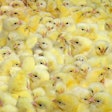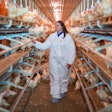
New chicken sex identification technology that uses cameras and artificial intelligence (AI) to quickly identify chick sex at a 99% accuracy rate could help poultry producers reduce their labor and increase the accuracy of their sexing process.
This technology can help poultry producers with labor and training costs, low efficiency and reduced accuracy in their chick sex identification process, explained Lihu Zhang, Shanghai Xiashu Intelligent Company research scientist and managing director, at the 2023 Poultry Tech Summit.
“The machine can sex almost twice as many chicks compared to a human at 1,000-1,200 chicks per hour using a non-invasive camera, compared to a human which can check 500-700 chicks on average,” he added.
The training process involves technicians travelling to customers to teach them how to operate the machine and conduct maintenance. According to Zhang, training to use the machine typically takes five days, while it normally takes approximately four months to train a human on standard sexing methods.
Additionally, Zhang said that due to high training costs, age and skill needed for humans to perform the task accurately, the salary for the job is normally over US$60,000 annually in western countries, making the AI technology less costly.
The vent sexing machine is currently being used in 10 countries. However, Shanghai Xiashu Intelligent Company is more looking for partners to trial its chick sexing technology commercially.
How it works
The machine contains industrial cameras that capture images of the chicks’ vents. Then, it uses algorithms to non-invasively identify the chick’s sex.
The machine’s algorithm uses millions of pictures of almost 30 different species to accurately sex white and colored broilers, layers and turkeys.
The sensors automatically detect and take pictures of the chick after the operator turns the anus of the chick toward the camera. There is no contact between the sensors and the chicks during the identification process, which takes less than three seconds. After identification, the machine automatically sorts the male and female chicks.
















